DISMEMBERED
LAPAROSCOPIC PYELOPLASTY WITH ANTEGRADE PLACEMENT OF URETERAL STENT: SIMPLIFICATION
OF THE TECHNIQUE
(
Download pdf )
HENRIQUE RODRIGUES, PAULO RODRIGUES, MARCOS RUELA, ANTÔNIO BERNABÉ, GILBERTO BUOGO
Instituto Albarran de Urologia, Rio de Janeiro, RJ, Brazil
ABSTRACT
Laparoscopic pyeloplasty is an effective treatment option for ureteropelvic junction obstruction, with success rates superior to other minimally invasive approaches. We describe our technique of laparoscopic pyeloplasty with antegrade placement of ureteral stent with a laparoscopic-guided abdominal puncture. This technique decreases the use of fluoroscopy and also facilitates renal pelvis dissection and ureteropelvic anastomosis.
Key words:
laparoscopy; kidney; ureter; ureteral obstruction
Int Braz J Urol. 2002; 28: 439-45
INTRODUCTION
In
recent years many treatment modalities have been developed to manage ureteropelvic
junction obstruction (UPJO), such as antegrade or retrograde endopyelotomy,
the Acucise cutting balloon, and ureteral dilation. Despite they are all
minimally invasive alternatives, the success rates of these procedures
is low (70-80% in well-selected patients) when compared to the traditional
open pyeloplasty, with success rates around 90% (1,2).
In 1993 Schuessler et al. (3) performed
the first laparoscopic pyeloplasty and since then many papers have shown
that this technique is a safe and effective treatment for UPJO (4,5).
One of the most difficult steps in laparoscopic pyeloplasty is the ureteropelvic
anastomosis when the classic dismembered technique (Anderson-Hynes) is
performed. Beyond the complexity imposed by the intracorporeal suturing,
the presence of an ureteral stent (previously placed by cystoscopy) in
front of the anastomotic site makes the suture even more difficult and
time-consuming.
We developed an alternative technique for
placing the ureteral stent in an antegrade fashion, through a laparoscopic
guided percutaneous puncture. This technique decreases the use of radiation,
and facilitates the ureteropelvic junction (UPJ) dissection and the ureteropelvic
anastomosis.
SURGICAL TECHNIQUE
Preoperative
Evaluation
All patients undergo an intravenous pyelogram
with furosemide and a renal scan preoperatively. If the surgeon intends
to perform a retrograde pyelogram prior to the surgery, this can be done
just before the laparoscopic access, or preoperatively in a separate procedure,
as no preoperative stent is placed.
Patient
Preparation
All patients are admitted to the Hospital
the day before surgery, and begin oral bowel preparation with sodium phosphate,
and intravenous antibiotic prophylaxis with cefazolin 1 hour before the
surgical procedure.
Bladder
Catheterization
In the operating room, bladder catheterization
is performed with an 18F 3-way Foley catheter. The irrigation path of
the Foley catheter is connected to a 500cc bottle of 0.9% saline solution
mixed with methylene blue.
Patient
Positioning
The patient is positioned in a slight flank
position with the side to be operated rotated up to 45o with a role (Figure-1).
The pressure points are protected with pads, and the patient is fixed
to the table with cloth tape, allowing the table to be rotated during
the surgery. The surgeon and the camera are placed in the contralateral
side with the TV monitor in front of them.
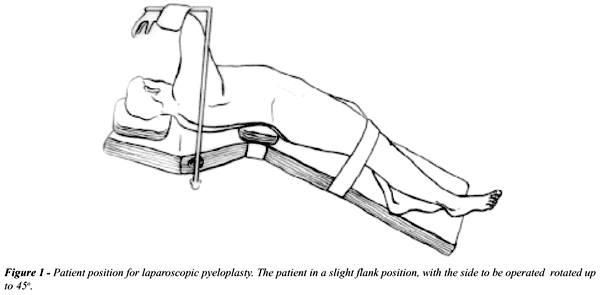
Port Placement
We routinely use transperitoneal approach
to access the UPJ. After the creation of pneumoperitoneum with a Veress
needle (with abdominal pressure of 12mmHg), we place the three 10-12mm
ports in a linear configuration at the midline for right pyeloplasty.
For the left side, we place the right-hand trocar just lateral to the
lateral border of the rectus muscle (Figure-2). The middle trocar is positioned
in the umbilicus for both right and left sides. A fourth 5mm trocar may
be placed, if necessary, in the subcostal region at the level of the anterior
axillary line, and may be used to retract adjacent organs.

Colon
Mobilization and Ureter and Renal Pelvis Identification
The parietocolic and renocolic ligaments
are divided, allowing the colon be moved medially, thus providing exposure
of the retroperitoneum (Figure-3). At this point, the dilated renal pelvis
can be seen posteriorly to the colon. The administration of 20mg of furosemide
intravenously helps to dilate the renal pelvis (as it is not previously
catheterized), and facilitates its dissection. The ureter is identified
and isolated just below the inferior pole of the kidney, and carefully
dissected cranially up to UPJ, in order not to compromise its blood supply.
The anterior and posterior aspects of the renal pelvis and UPJ are dissected
with a gauze, creating as much space as possible to perform a tension-free
anastomosis.
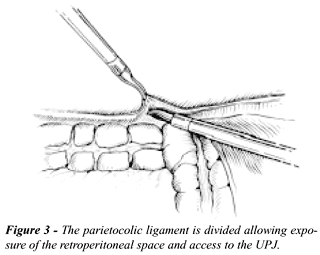
Renal
Pelvis Repair
After wide dissection of the renal pelvis
and UPJ, we pass a stitch through the anterior wall of the renal pelvis
in order to make its retraction possible from outside the peritoneal cavity,
avoiding the need of another trocar. For this purpose, a 3-0 nylon with
a straight needle is introduced through the abdominal wall, about 1cm
lateral to the most cranial port. As it is seen on the monitor, the needle
is taken by the laparoscopic needleholder, passed through the inferior
border of the renal pelvis on its most dependent portion, and then through
the abdominal wall again, from inside to outside, as close as possible
to its entrance site (Figure-4). The two ends of the suture are grasped
with a hemostat, allowing the assistant to retract the anterior wall of
the renal pelvis by simply pulling up the hemostat and thus opening the
UPJ.
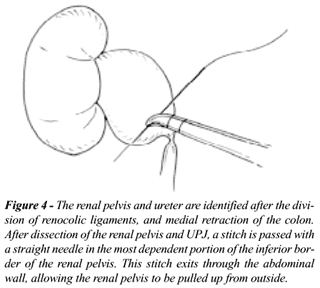
UPJ Resection
and Ureteropelvic Anastomosis
The obstructed UPJ is resected together
with the redundant renal pelvis when necessary (Figure-5). When the UPJ
is resected, care should be taken not to cut the nylon stitch previously
placed. The ureter is then spatulated on its lateral aspect (facing the
medial aspect of the kidney) (Figure-6). We routinely perform interrupted
suture with 5-0 polygalactin. The first stitch is passed in the medial
angle of the anastomosis outside-in on the renal pelvis, and then inside-out
on the ureter (Figure-7). The other sutures are placed in the posterior
wall in the same fashion, in order to locate all the knots in the extraluminally.
At this point, it is crucial to keep the nylon stitch pulled, maintaining
the renal pelvis opened, and thus facilitating the sutures placement.
The absence of a previously placed ureteral stent in the surgical field
at this point makes posterior wall anastomosis easier to perform.

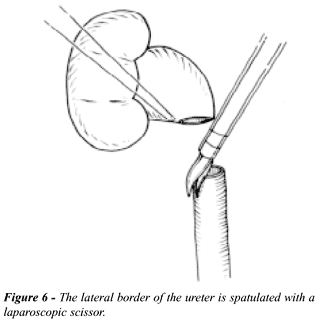
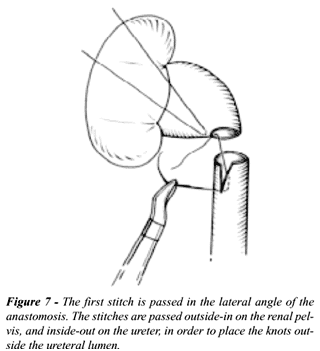
Percutaneous Stent Placement
After completing the anastomosis of the
posterior wall, a 7F ureteral stent (double-J) will be inserted in an
antegrade fashion. An abdominal puncture is made with a 18G needle used
for peripheral venous access. The needle is placed cephalad to the anastomotic
site, towards the ureteral axis. A 0.035” hydrophilic guidewire is
inserted through the needle that, after entering the peritoneal cavity,
is inserted in the ureter with a laparoscopic forceps (Figure-8). The
presumed length of guidewire necessary to reach the bladder is inserted.
The abdominal wall is dilated using dilators from a nephrostomy set until
number 8F, permitting the passage of the double-J. The dilators can also
be used to facilitate the introduction of the guidewire in the ureter,
when the indroduction with the grasper is difficult. The double-J stent
is then introduced through the guidewire in the abdominal cavity and penetrates
the ureteral orifice with the aid of the positioner (Figure-9). Before
introducing the entire stent, the bladder is filled with the saline solution
mixed with methylene blue, previously connected to the Foley catheter.
As the stent reaches the bladder, one may observe the exit of methylene
blue through the anastomotic site, confirming the adequate placement of
the stent and avoiding the need of radiologic control. After that, the
guidewire is removed and only the proximal end of the stent will be outside
the anastomosis (Figure-10). With a grasper, this part of the stent is
introduced in the renal pelvis under direct vision (Figure-11). The anterior
wall of the anastomosis is then completed with interrupted sutures (Figure-12),
in a similar fashion of what was made for the posterior wall, and a suction
drain is placed near the UPJ. If there is minimal output from the retroperitoneal
drain, the bladder catheter is removed on postoperative day 2. The retroperitoneal
drain is removed shortly thereafter if there is no increase in output.
The ureteral stent is generally removed in 6 weeks.
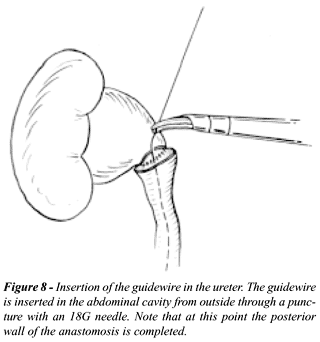
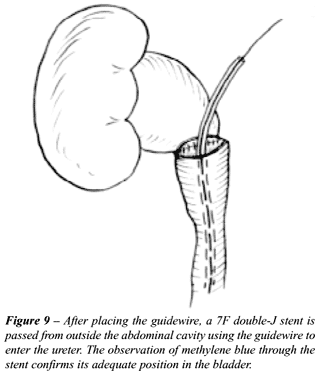
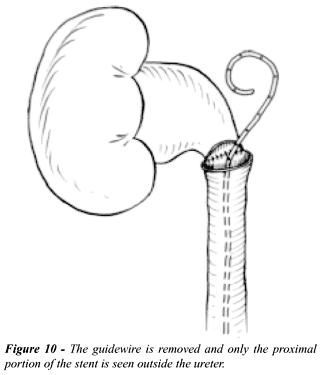
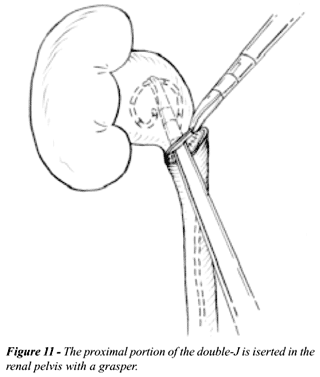
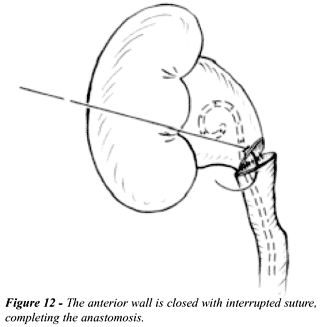
Follow-up
An intravenous pyelogram with furosemide is performed 2 months after stent
removal if the patient is without any symptoms. A renal scan is performed
annually thereafter, if the patient is still symptom-free.
COMMENTS
Laparoscopic
pyeloplasty is a safe and effective procedure to treat UPJO. There is
a clear advantage over other minimally invasive approaches and open procedures
in respect to results and morbidity, respectively (4).
We believe that the placement of the stent
through an antegrade fashion may decrease radiation exposure and maintain
the renal pelvis dilated, facilitating its dissection and, consequently,
the anastomosis.
REFERENCES
- Nadler RB, Rao GS, Pearle MS, Nakada SY, Clayman RV: Acucise endopyelotomy: assessment of long-term durability. J Urol. 1996; 156: 1094-7.
- Scardino PT, Scardino PL: Obstruction of the Ureteropelvic Junction. In: Bergman H (ed.), The Ureter. New York, Springer-Verlag; 1981, p. 697.
- Schuessler WW, Grune MT, Tecyanhuey LV, Preminger GM: Laparoscopic dismembered pyeloplasty. J Urol. 1993; 150: 1795-8.
- Bauer JJ, Bishoff JT, Moore RG, Chen RN, Iverson AJ, Kavoussi LR: Laparoscopic versus open pyeloplasty: assessment of objective and subjective outcome. J Urol. 1999; 162: 692-5.
- Jarret TW: Technique of laparoscopic pyeloplasty. Braz J Urol. 2000; 26: 76-81.
____________________
Received: April 24, 2002
Accepted after revision: August 21, 2002
_______________________
Correspondence address:
Dr. Henrique Rodrigues
Rua Djalma Ulrich, 329 / 301
Rio de Janeiro, RJ, 22071-020, Brazil
Fax: + 55 21 2579-2358
E-mail: hcrodrigues@uol.com.br
The
authors are to be congratulated for developing a technique for placing
and confirming ureteral stent placement during laparoscopic pyeloplasty.
Over the last 12 years, laparoscopic urology has evolved from primarily
a diagnostic modality to become a radical, extirpative procedure. The
field continues to grow to encompass reconstructive procedures such as
laparoscopic pyeloplasty, as well as vesical-urethral anastomosis during
laparoscopic prostatectomy.
Reconstructive laparoscopic procedures can
be performed using either the Endostitch or free hand laparoscopic suturing
using a needle driver. Robotic suturing may also prove to bridge the gap
in laparoscopic training to allow urologists to perform complex laparoscopic
procedures. As the surgeon places their hands at a remote console and
moves handles located beneath a console, a robotic arm duplicates their
hand movements with precision. Robotic instruments such as electrocautery,
needle drivers, graspers, and scissors can then be used to perform complex
laparoscopic procedures. The robotic articulated needle driver allows
a larger range of motion compared to standard laparoscopic needle drivers
which have fixed insertion sites at the trocar level, a limited range
of motion, and limited angles. A three dimensional viewing screen also
increases the depth of perception which may also aid the surgical perspective.
The limitations of robotics include cost as well as lack of haptic, or
force feedback. Currently, only visual clues are employed in order to
determine the force being applied. This will be the next technological
hurdle to overcome.
The use of methylene blue in this manuscript
avoids the need for fluoroscopy, as well as the need for cystoscopy and
placement of a ureteral stent at the beginning of the procedure. The only
caveat in performing the procedure this manner is that the distal ureter
and ureteropelvic junction anatomy is not evaluated by retrograde pyelogram
prior to the procedure, unless an intravenous pyelogram adequately delineates
this anatomy.
Benjamin R. Lee, M.D.
Assistant Professor of Urology
Director, Laparoscopy Section
Long Island Jewish Medical Center
New Hyde Park, New York, USA